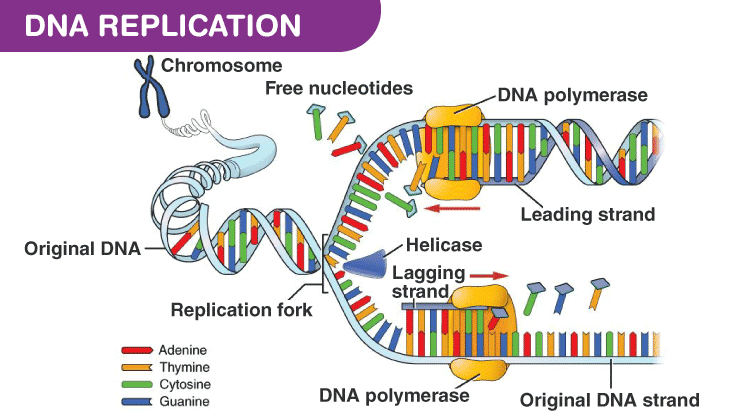Science | Academic | Mar 15, 2016
What are the Steps involved in DNA Replication?

The complete process of DNA Replication involves the following steps:
1. Recognition of initiation point
– DNA replication starts at a specific point called initiation point or origin where replication fork begins. This is a nucleotide sequence of 100 to 200 pairs of bases.
Specific initiation proteins recognize the initiation site on DNA. Such proteins along with DNA directed RNA polymerase initiate the synthesis of RNA primer for the formation of DNA chain. Prokaryotic chromosomes usually possess one initiation point or replication fork., whereas the eukaryotic chromosomes may possess several replication forks.
Nicks are produced by the endonuclease enzyme.
2. Unwinding of DNA –
When the DNA duplex molecule is cut open (nicked) to form a bubble or fork the unwinding proteins get attached at the point of nick which helps in the separation of the strands of the DNA duplex.
3. Template DNA –
The single stranded DNA on which the new DNA is synthesized is called template DNA.
4. RNA Primer –
Pre formed polynucleotide chain is necessary to start the synthesis of DNA. RNA polymerase synthesizes RNA primer on template DNA. In the absence of RNA primer the DNA replication is irregular.
5. Chain Elongation –
New DNA strand is formed due to DNA polymerase III enzyme. This enzyme adds nucleotides in 5’ to 3’ direction. This activity of DNA polymerase is called polymerizing.
6. Replication forks –
Due to opening of the DNA strand a replication fork is formed.
Okazaki fragments –Polymerizing activity of polymerase III enzyme takes place only in 5’ to 3’ direction. Thus one of the two strands of DNA having 3’ to 5’ polarity gets continuous synthesis of DNA, hence called continuous strand. The other strand having 5’ to 3’ polarity gets synthesis of DNA in small fragments called Okazaki fragments, after the name of the scientist who first discovered them.
Since the synthesis of the strand takes place in fragments, the strand is called the discontinuous strand. The synthesis of DNA on this strand is opposite to the movement of replication fork.
Thus this strand is called the lagging strand, while the continuous strand is called the leading strand.
Ligation – RNA primers are exited out once the replication is finished. The gaps formed are sealed by polynucleotide ligase enzyme. This enzyme is active in the presence of NADP, in the case of prokaryotes and ATP in the case of eukaryotes.
Replication can be unidirectional or bi directional.
7. Proof reading –
DNA replication is a very complex process. If any error is made during the replication it may lead to mutation. The DNA polymerase I and polymerase III act as proof readers of the newly formed DNA. They move along the new synthesized DNA, read mistakes formed due to improper base pairing and correct those through 3’ to 5’ exonuclease activity.
8. Removal of RNA primer and completion of DNA strand –
when the okazaki fragments are formed most of the lagging strand is duplicated. The RNA primer is removed by DNA polymerase I which synthesizes a short segment of complimentary DNA to seal the gap. Polymerase I remove the primer one nucleotide at a time and replace it with complimentary deoxyribonucleotide.
9. Joining of fragments –
At the end the fragments are joined by DNA ligate that forms a phosphodiesterase bond between 3’ OH end of the growing strand and 5’ end of the okazaki fragment.
Find a Online Biology tutor or Call us for Biology Tutoring at +1 855 688 8867.












Post a Comment: